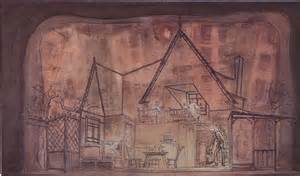In our continuing series on those who changed the American Theatre we consider a playwright, designer and director/choreographer. Here’s a look at playwright Susan Glaspell, scenic and lighting designer Jo Mileziner, and A Chorus Line “creator” Michael Bennett.
 Susan Glaspell
Susan Glaspell
Although Susan Glaspell’s name is often said in connection with her husband George Cram Cook, she stands alone in her career and contributions to the American theatre. With Cook, she created the highly influential Provincetown Players (1915-1923), which first produced the plays of Eugene O’Neill. Glaspell proved to be a fine playwright herself, giving us the drama Trifles (1916), which is considered by many to be one of the finest one-act plays by any American dramatist. It was her first play, which makes it even more astounding.
By 1918, she was considered to be one of America’s finest playwrights, and by 1920 she was seeing great success in England. Along with plays, Glaspell wrote successful novels and short stories. She gained even more recognition as a dramatist when her play Alison’s House won the 1932 Pulitzer Prize for Drama. Over the course of her career, she wrote nine novels, 15 plays, more than 50 short stories, and one biography.
In the 1940s, critics disparaged her work and she fell out of favor. In addition, Glaspell often downplayed her contributions to the American theatre and for 30 years she was forgotten. However, in the 1970s, feminist critics took a new look at her work and Glaspell became to be seen for what she was, a writer who focused on important issues related to gender, dissent, and human rights; a groundbreaking visionary who helped create a new type of theatre in the US, and an accomplished artist.
 Jo Mielziner
Jo Mielziner
Designer Jo Mielziner is considered by many to have been the very best and most influential designer of the 20th century. Mielziner, who designed the sets and lights for more than 200 Broadway shows, won seven Tonys and received a total of 12 nominations. In the 1920s, he spent more than a year in Europe focusing on the New Stage Craft, and when he returned to the US. Mielziner brought with him a new way of envisioning the stage and the manner in which a scenic and lighting designer could contribute to a production.
He pioneered selective realism and his designs often captured the inner psychological working of the central character as well as highlighting themes and facilitating a show’s progression. He created iconic designs for the original productions of Death of a Salesman, Winterset, and A Streetcar Named Desire. Equally at home with musicals, he designed the original productions of Carousel, Guys and Dolls, The King and I, and South Pacific.
Mielziner’s work was highly influential in many ways, and the overall effect of his designs in terms of not just capturing a show’s essence, but in also being an evocative force and tool in the physical, emotional, and psychological progression of a show are still very much a part of today’s theatre art.

Michael Bennett, A Chorus LineMichael Bennett, A Chorus Line
Michael Bennett
Director/choreographer Michael Bennett is best known for having developed the hit musical A Chorus Line. When A Chorus Line opened on Broadway on July 25, 1975, it did create “one singular sensation” that would result in sold out houses at the Shubert Theatre for close to 15 years. It’s run of 6,137 performances created a new record for long runs on Broadway, and it is still in the top 10 of The Great White Way’s longest running shows.
Bennett’s methodology and his story telling was something new to American musical theatre. However, in many ways the end result, what was seen on the Shubert Theatre stage, may be considered to be less influential than how A Chorus Line came to be.
The story was that Bennett had developed A Chorus Line by interviewing dancers who had Broadway aspirations, and from that developed a production at the Public Theatre that was a series of monologues and included music byMarvin Hamlisch, lyrics by Edward Kleban and a book by James Kirkwood, Jr. and Nicholas Dante. However, later it was learned that Bennett was originally invited to observe a process in which several taped workshop sessions with Broadway dancers were hosted by Michon Peacock and Tony Stevens. Both Peacock and Stevens were dancers who were interested in creating workshop opportunities for Broadway dancers, who are also known as “gypsies.”
Bennett soon took over those sessions and from the interview process eight of those dancers and their stories were selected to be a part of the original Broadway cast. Later, when he claimed that A Chorus Line was his idea from the start and his creation, there were various lawsuits. One misgiving that many of those who participated in the creation of the new show had was the fact that they signed away their story and contribution to A Chorus Line for $1.00, and later they were cut from the musical.
The major way in which A Chorus Line and Michael Bennett influenced Broadway and the rest of the American theatre was the manner in which an actor’s contributions were to be weighed in the creation of a new show. The result of what happened with A Chorus Line was the creation of the Equity Workshop Contract. Now, if a performer participates in what is a four-week Equity workshop, they sign this contract, which, whether they are cut from the show or continue on with it, guarantees them a spilt with the other original cast members of a 1% royalty of that show’s ticket sales.
